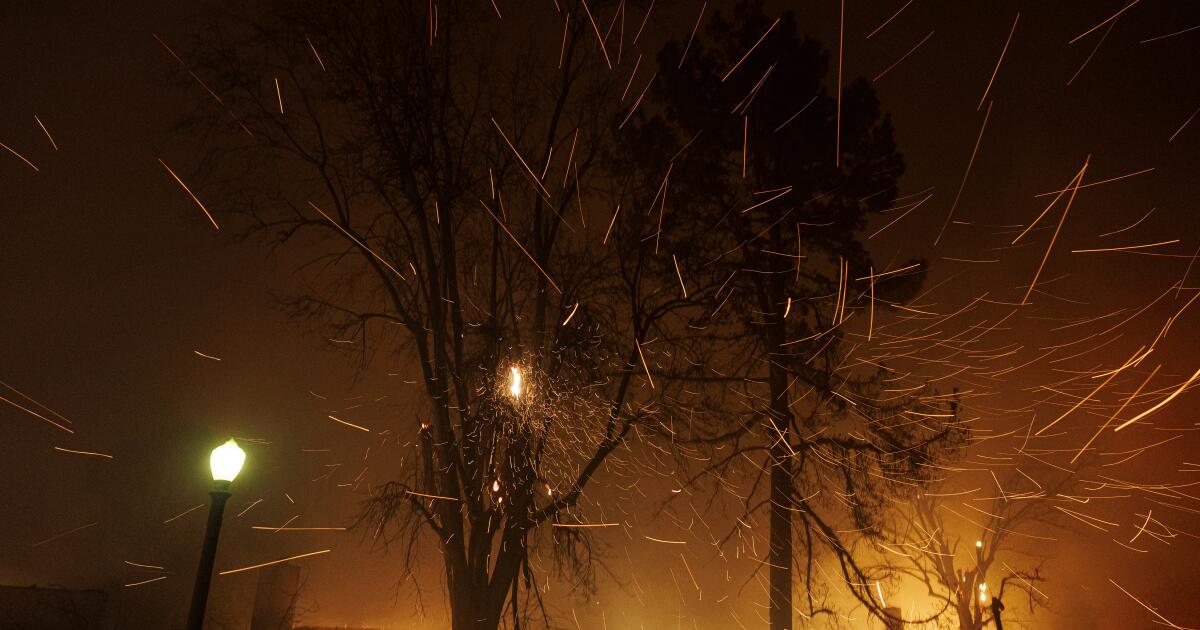99-mph winds bring a night of terror as fires rock SoCal communities

Strong winds and gusts – up to 99 mph – were reported as three large wildfires burned homes and businesses in Los Angeles County Wednesday morning.
The National Weather Service reported a gust of 99 mph near Altadena at 10:20 pm Tuesday; 98 mph near Woodland Hills at 9:37 pm; and 84 mph at Hollywood Burbank Airport at 8:30 pm
Officials said this is no ordinary Santa Ana wind event, although it does bring dry, coastal air to the area. Forecasters have warned that the event may be accompanied by weather that can create short-lived but very destructive winds; its effects were expected to be felt especially in the San Gabriel mountains and valleys.
“Mountain wave wind” activity occurs when a storm moves quickly down mountain slopes, then gains strength as it hits flat land, causing “short bursts of very strong, dangerous winds,” NWS meteorologist Rich Thompson said ahead of the first of three fires in the state. LA, the Palisades fire, broke out on Tuesday.
He said this could be the strongest wind event since the 2011 hurricane that wreaked havoc in Pasadena, Altadena and other areas of the San Gabriel Valley, knocking out power for more than 400,000 people for days. The 2011 hurricane caused at least $40 million in damage, according to preliminary estimates.
“If it happens, it could cause some damage,” Thompson said before this week’s fires broke out. “Think like a wave in water. … Those winds are like going down a slope, and then they just blow up and become very strong.”
On Tuesday night, increasing winds made aerial attacks against the wildfires impossible. Terrible winds forced crews to ground planes as they battled the Palisades fire shortly before 8 p.m. Tuesday.
About two hours earlier, the Eaton fire broke out in the hills above Altadena near Eaton Canyon. Strong winds led officials to suspend aerial coverage of the Eaton fire for the evening, officials said at 8:45 p.m.
A lack of rain has extended the fire season in Southern California. Since October 1, the start of the water year, the city of Los Angeles has received 0.16 inches of rain — a fraction of the 4.64 inches the city receives, on average, by this point in the season.
In contrast, Northern California did not experience such fire weather, with above-average rainfall. Downtown San Francisco has received 10.39 inches of rain since Oct. 1 – more than the 9.29 inches of rain the city is receiving on average at this point in the season.
“Southern California had a very hot summer, followed by almost no rain during a normally rainy period,” said Alex Hall, director of the UCLA Center for Climate Science. “And all of this comes after two years of heavy rains, which means there’s plenty of fuel for wildfires.”
The worst fire conditions are expected to continue through mid-Wednesday afternoon, the weather service said by midnight Wednesday. “Any wildfires that do start will likely spread quickly with extreme fire behavior,” the weather service said.
Another Santa Ana wind event is expected on Friday. But it’s expected to be “normal,” the NWS said, with winds from the northeast “centered in the general Santa Ana wind tunnel, from the Santa Clarita Valley to Point Mugu. … Lowering winds will also reduce moisture and increase fire danger.” “
The weather service warned that winds will be “gusty and variable, with calm between storms.”
Ahead of Tuesday’s fires, the National Weather Service issued a “particularly dangerous” red flag warning, warning of severe fire weather (abbreviated as PDS). The weather service issued a similar warning about a month ago — when the Franklin fire was burning and spreading rapidly in the Malibu area. It went on to burn more than 4,037 hectares, destroying 20 structures and damaging 28 others.
An infographic from the National Weather Service that explains the most dangerous condition is a red flag warning.
(National Weather Service)
And a month before that, a dangerous red flag warning was issued on election day. The next day, on Nov. 6, the Mountain fire burned in Ventura County and, fanned by strong winds, destroyed more than 240 structures. It was the third deadliest wildfire in Southern California since 2013, and burned 19,904 acres.
This type of red flag warning is expected to occur, on average, once every three to five years. But the National Weather Service office in Oxnard has now issued such a warning three times this fire season alone. The office issues forecasts for LA County, as well as Ventura, Santa Barbara and San Luis Obispo counties.
Before November, the last time a red flag severe weather warning was issued by the National Weather Service for LA and Ventura counties was in 2020, the first year of such warnings in the region. That kind of warning was issued twice in 2020 – once in October and again in December.
Source link

